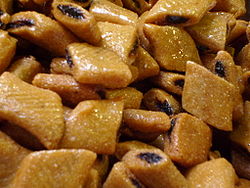Top Qs
Timeline
Chat
Perspective
Makroudh
Semolina cookie with filling From Wikipedia, the free encyclopedia
Remove ads
Makroudh (Arabic: مقروض, romanized: maqrūḍ), also spelled Makrout, is a cookie from the cuisine of the Maghreb. It is filled with dates and nuts or almond paste, that has a diamond shape[2] – the name derives from this characteristic shape.
The dough is made with a combination of semolina and flour, which gives the pastry a very specific texture and flavor. Makroudh can be fried in oil or oven-baked.[3]
It is popular in the Maghreb where there are many varieties of Makroudh, some of which are pastries that do not share much in common with the traditional Makroudh except the shape.[4][5] In Algeria, they may be filled with almond paste.[6] A variation with a fig filling in place of the dates is popular in Tunisia and Algeria.[7][1]
Makroudh with dates and honey is also popular during Eid al-Fitr.[8]
Remove ads
History
According to historian Daniel Newman, the oldest known recipe for maqrud dates back to a 13th-Century Arabic cookbook by Ibn Razīn al-Tujībī.[9] The recipe describes date-filled, fried dough.[10]
Preparation
Makroudh is prepared by filling a dough made with semolina, usually using the Deglet Nour date variety. The dough is then rolled and cut into diamond-shaped pieces. The pastry is then either fried or oven-baked. The final step involves soaking the makroudh in a sweet syrup.[11][12]
See also
References
Wikiwand - on
Seamless Wikipedia browsing. On steroids.
Remove ads

